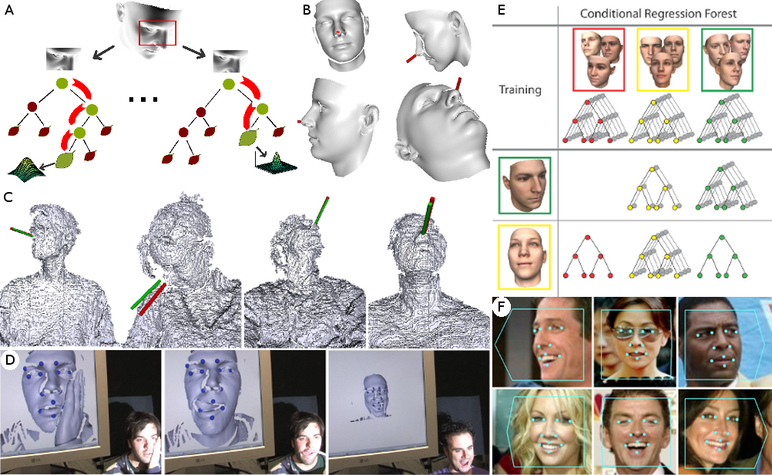
A. Regression forest for head pose estimation. For each tree, the tests at the non-leaf nodes direct an input sample towards a leaf, where a real-valued, multivariate distribution of the output parameters is stored. The forest combines the results of all leaves to produce a probabilistic prediction in the real-valued output space. B. Synthetically generated training data. The red cylinder attached to the nose represents the ground truth face orientation. C. Head pose estimation for Kinect data. The green cylinder represents the estimated head pose, while the red one shows the ground truth. D. Real-time facial feature detection from depth data. E. While a regression forest is trained on the entire training set and applied to all test images, a conditional regression forest consists of multiple forests that are trained on a subset of the training data illustrated by the head poses (colored red, yellow, green). When testing on an image (illustrated by the two faces at the bottom left), the head pose is predicted and trees of the various conditional forests (red, yellow, green) are selected to estimate the facial feature points. F. Head pose and facial feature estimation from images.
Due to its relevance for many applications like human computer interaction or face analysis, head pose estimation or facial feature point detection are very active areas in computer vision. Recent state-of-the-art methods have reported impressive results for these tasks where estimation accuracies of human annotators have been achieved. However, most of the available methods do not achieve real-time performance which is a requirement for many applications. We therefore address the problem of accurate head pose estimation or facial feature point detection in real-time from different modalities like images or depth data captured with a consumer depth camera.
To this end, we rely on a voting framework where patches extracted from the whole image can contribute to the estimation task. The intuition is that patches belonging to different parts of the image contain valuable information on global properties of the object which generated it, like pose. Since all patches can vote for the localization of a specific point of the object, it can be detected even when that particular point is occluded. To achieve real-time performance without the need of specific hardware like GPUs, the voting framework is implemented by random regression forests. Regression forests are a versatile tool for solving challenging computer vision tasks efficiently, being very fast at both train and test time, lend themselves to parallelization, and are inherently multi-class. Furthermore, they allow to find easily an optimal trade-off between accuracy and speed for a specific application. In this project, regression forests are used to learn a mapping from local image or depth patches to a probability over the parameter space, e.g., the 2D position of a facial feature point or the 3D orientation of the head.
Regression forests show their power when using large datasets, on which they can be trained efficiently. Because the accuracy of a regressor depends on the amount of annotated training data, the acquisition and labeling of a training set are key issues. Depending on the expected scenario, one can synthetically generate annotated depth images by rendering a face model undergoing large rotations, by recording real sequences using a consumer depth sensor and automatically annotating them using state-of-the-art tracking methods, or by crowd sourcing.
In the context of facial feature detection, regression forests tend to introduce a bias to the mean face since they learn the spatial relations between image patches and facial features from the complete training set and average the spatial distributions over all trees in the forest. In particular, patches that are not very close to a facial feature point favor the mean face, whereas patches close to a facial feature adapt better to local deformations but are more sensitive to occlusions. To find a good trade-off, the impact of the patches is steered based on the voting distance.
Another issue is the high intra-class variation of the data, which we address with the concept of conditional regression forests. In general, regression forests aim to learn the probability over the parameter space given a face image from the entire training set, where each tree is trained on a randomly sub-sampled training set to avoid over-fitting. The proposed conditional regression forests aim to learn several conditional probabilities over the parameter space instead. The motivation is that conditional probabilities are easier to learn since the trees do not have to deal with all facial variations in appearance and shape. Since some variations depend on global properties of the face like the head pose, the trees can be learned conditional to the global face properties. During training, the probability of the global properties are also learned to model the full probability over the parameter space. During testing, a set of pre-trained conditional regression trees is selected based on the estimated probability of the global properties. For instance, having trained regression trees conditional to various head poses, the probability of the head pose is estimated from the image and the corresponding trees are selected to predict the facial features. In this way, the trees that are selected for detecting facial features might vary from image to image. On a challenging database of faces captured ``in the wild'', the method achieves an accuracy comparable to the performance of human annotators in real-time.
Our current research is focused on extending the approach to profile faces and estimating occlusions of facial feature points as well.
